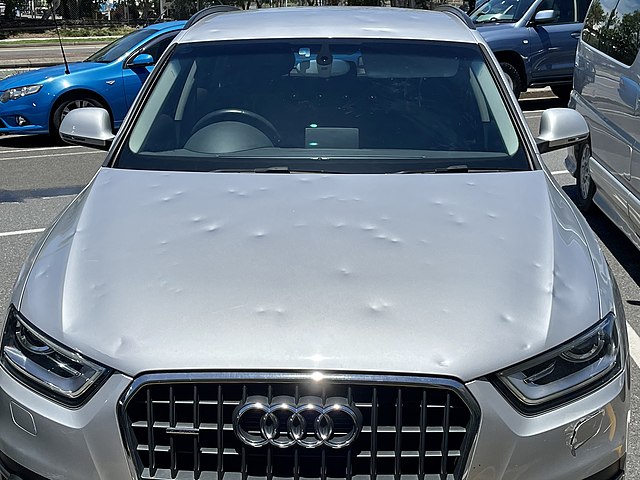
Hailstorms can cause severe damage to buildings and cars. Every year, hailstorms cause damage to millions of homes and businesses across the country. Property owners can lose thousands of dollars due to this damage. Most standard insurance policies should cover hail damage. Insurance companies are often businesses, and they may be more concerned with making a profit than paying for the repair of the property.
Hail storms are more common in Wyoming, Nebraska, and Colorado (this area is known as Hail Valley), but they can strike anywhere. Even the southern states of Florida and Georgia aren’t immune to hail storms. Hail damage can happen to anyone, regardless of where they live or their property. Hail Damage is one of the most common reasons homeowners file insurance claims. Hailstorm damage is responsible for up to 70% of all claims.
Hailstorm damage can cause severe havoc in your life. Your insurance company is supposed to protect you. It would help if you held them responsible for not meeting your needs. It isn’t easy to get insurance companies to do the right things. This is especially true if you are not a hailstorm damage lawyer.
Vaval Law can help you if hail has damaged your property and your insurance company denies your claim. Vaval Law may be able to help you file a lawsuit against your insurance company. Contact us immediately for a complimentary consultation.
Hail Damage
Hail can do a lot depending on how strong the storm is and the speed at which it blows. Any property exposed to the elements can suffer hail damage. This includes vehicles and buildings that aren’t protected by garages.
Car damage
Hail damage to cars could include:
- Car body dents
- Broken windshield
- Broken windows
- Engine damaged
Building Damage
Home damage can be extensive from hail damage. Even minor hail damage can cause severe damage that could cost thousands of dollars. Hail damage should be repaired quickly to avoid further damage.
Hailstorm damage to homes or other buildings could include:
- Broken windows or screen damage
- Metal roofs with dents
- Roof damage includes missing or damaged shingles and dented metal roofs
- Leaks
- Flashing and vent damage
- Siding that is damaged
- Peeling paint
- Exposed and rotting timber
- Air conditioner damaged
- Chimneys and flue vents damaged
Is insurance coverage for hail damage?
The insurance company and policy will determine whether hail damage is covered. Homeowners insurance typically covers you against hailstorm damage, theft, lightning, and windstorms.
These are the most important facts to remember when filing an insurance claim against hail damage.
Dwelling Coverage (Coverage B)
Dwelling coverage, also known as Coverage A, is the portion of your homeowner’s insurance policy that covers any reconstruction or repair of your home due to perils like hail, wind, storms, etc. Hail is often included in standard Coverage A policies.
Hailstorm damage usually is covered by homeowners insurance policies under Coverage A or dwelling coverage. Dwelling A coverage typically covers parts of the house such as roofs, windows, and decks. This coverage may also include outbuildings such as garages and tool sheds.
Every insurance policy is different. However, you should verify the coverage of your policy. In the event of a total loss, your policy should cover the full value of your home.
Hail Insurance
A particular hail-specific type of insurance is available, but this insurance is typically only available to farmers. This specific insurance, crop hail insurance, covers hail damage to crops.
Hail Deductible
You may have a deductible on your insurance policy for hail damage. Your insurance policy may have a deductible that you must pay for repairs before the insurance company starts paying.
To ensure your policy covers your entire property, you will need to review your specific policy. You can also check your policy and contact your insurance company to find out what hail coverage is available.
Additional coverage
Although most homeowners insurance policies cover hail damage, you might consider adding coverage. Many insurance providers offer additional coverage for roof replacement, siding, fencing, and other structures. These premium insurance options will be available to you from your insurance provider.
Is my car insurance able to cover hail damage?
Your insurance policy may not cover vehicle hail damage if you only have auto liability insurance. Comprehensive insurance policies typically cover hail damage. The same procedure you have and the company you are with will determine whether hail damage is covered. To be sure you understand what your policy covers, it is a good idea to read it thoroughly.
How to file an insurance claim for hail damage
Before taking legal action, ensure your hailstorm damage claim is filed with your insurance company. You must ensure that the hailstorm damage claim is filed correctly. The insurance company shouldn’t have any reason to deny your claim.
Assess the damage
Assessing the damage is the first step to filing a claim. Examine your property for any damage or broken items. Inspect your property for damaged siding or windows. Also, inspect your air conditioner. It would help if you inspected everything that opens to the outside, including decks, sheds, and garages.
Although it may be more challenging to assess the damage to your roof, you can hire an expert to inspect it before you call your insurance company. Numerous roofing companies offer free inspections in the hope that you will come back to them for actual roofing repairs.
Photograph the damage
Photographic proof is necessary when you evaluate the hail damage. Photograph everything that you can. It is essential to show evidence of damage, especially if repairs are not yet underway.
Get the damage professionally assessed.
The insurance company will send an adjuster to assess the damage if you file an insurance claim. Their assessment might be biased toward the insurance company. An independent inspector can help you get a better understanding of the actual cost of damage. An independent professional not associated with an insurance company can help you avoid filing a more minor than necessary claim.
Hailstorms are not always a cause of severe damage that requires repairs. You may not need to file a claim if the damage is only cosmetic. Insurance companies do not always cover cosmetic damage. A professional might advise you to hold off on making any repairs.
It might be a good idea for the professional to visit your home with the insurance adjuster. This will allow them to point out any damage to the adjuster so they won’t miss it.
Reexamine Your Insurance Policy
You should know what your policy covers. However, after a hailstorm, it is an excellent time to review. It is essential to know if your insurance company covers all damage or if you have any restrictions. Some insurance policies don’t cover cosmetic damage. You may be required to pay a deductible before your insurance company covers you.
Notify Your Insurance Company
The next step in a claim is to make it. It is a good idea to file a claim as soon as possible. Roof leaks can be caused by hail and, if not repaired, can cause severe damage to your home. Even if your air conditioner is in good condition, it may be more damaged than before or need to be replaced entirely. If it isn’t addressed immediately, other damage could worsen and cause further damage to your property.
Your insurance company won’t pay for damage caused by repair delays. They will only pay the amount they determine to be the actual damage, as per your policy’s limits, and after deducting any excesses.
Maintain maintenance records
Keep all records of repairs. This would be crucial if your insurance company reimbursed you for out-of-pocket costs. You must keep records of all payments if you have a high deductible. This will help you prove that you met your deductible.
Log all Correspondence
Most insurance problems start with a simple claim. Keep a log of all interactions with your insurance company. You should include assets such as photos, call logs, and directives. These records can be instrumental if things go wrong.

